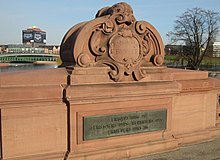Red Main sandstone


Red Main sandstone occurs in the southern Mainviereck and extends from the Spessart in the north to the Odenwald in the west. Its deposits extend over the federal states of Bavaria , Hesse and Baden-Württemberg and have been developed with numerous quarries. This sandstone was built in the period of red sandstone .
Mineralogy and Uses
It is a quartz-bonded sandstone with differently colored layers, which can be white-red-striped or evenly colored red. It contains both coarse and fine quartz grains . The compressive strength is between 700 and 1000 kg / cm².
The red Main sandstone has been used for a number of historical buildings. Today it is therefore widely used both for restoration work and as a brick, for facade panels, floor and stair coverings. These sandstones are frost-resistant.
The fine-grained layers of the Main sandstone around Miltenberg, the so-called Miltenberg sandstones , are primarily used by stone sculptors for sculptures , coats of arms and ornamented stone . The rock sandstone is reddish and medium-grained and contains little clay. The slab sandstone has layers of mica, is fine-grained and is mainly used for floor coverings and facade panels due to its hardness to wear.
This sandstone is said to have been used as a building block since Roman times. Numerous quarries from which the sandstone was extracted have been used for centuries and are now closed. Some of them are no longer recognizable as quarries, although almost every place on the Main extracted and built deposits of the Red Main sandstone in the immediate vicinity. The 16-ton, 6.40-meter-high and 1.20-meter-wide Heunensäule on the cathedral in Mainz, which is said to be over 1000 years old, is particularly valuable in terms of art history .
Occurrence
The thickness of the upper, middle and lower red sandstone is between 500 and 700 meters. From Miltenberg to Dorfprozelten the thickness is 200 meters. The Miltenberg sandstone belongs to the Lower Buntsandstein in the border area of the Calvörde and Bernburg Formations .
In the 1930s, the red sandstone was still extracted in numerous quarries: Miltenberg in Bavaria, Tauberbischofsheim in Baden-Württemberg, Stadtprozelten and Dorfprozelten in Bavaria, Freudenberg (Baden) and Rauenberg , Fechenbach and Heubach in Baden-Württemberg, Mömlingen , Adelsberg bei Gemünden am Main , Gössenheim and Reistenhausen in Bavaria. Today a number of new quarries are in operation.
Variety names and similar sandstones
Today, for example, the Red Main Sandstone is used in Miltenberg as Miltenberger Sandstone , in Wüstenzell as Wüstenzeller Sandstone , in Dietenhan as Dietenhan Rot , in Bürgstadt as Bürgstädter Sandstone , in Dorfprozelten as Dorfprozelten sandstone and in other quarries with special variety names that refer to the place of quarry , won.
The Neckar Valley sandstone and Odenwälder sandstone as well as the Black Forest red sandstone are practically indistinguishable from the Red Main sandstone without geological investigations.
See also
literature
- Wilhelm Dienemann , Otto Burre: The usable rocks in Germany and their deposits with the exception of coal, ores and salts. Volume 2: Wilhelm Dienemann, Wilhelm Ahrens , Otto Burre: Solid rocks. Enke-Verlag, Stuttgart 1929.
